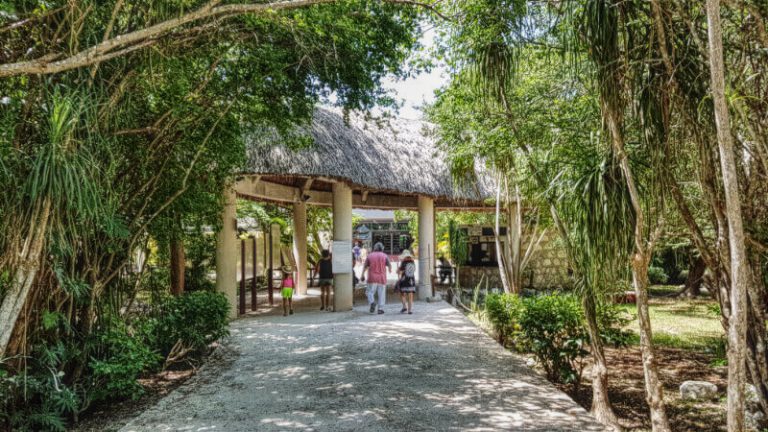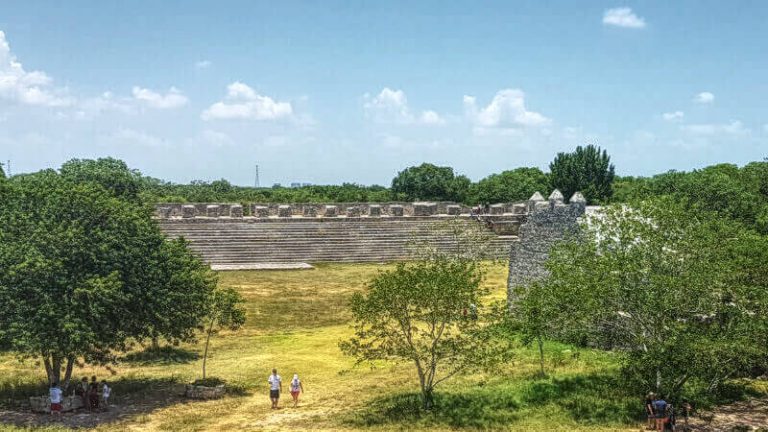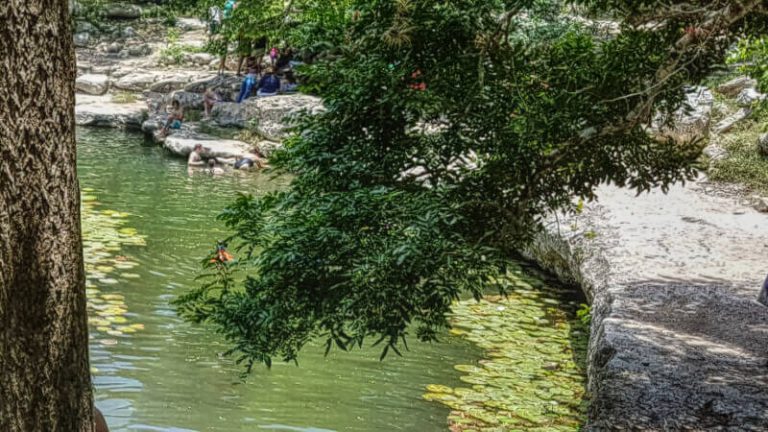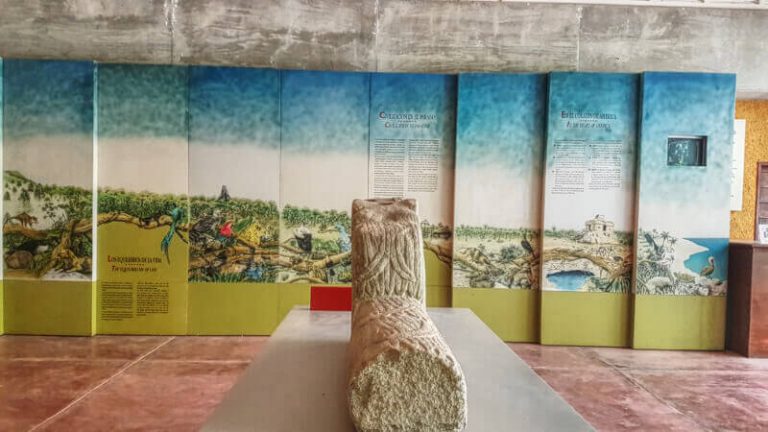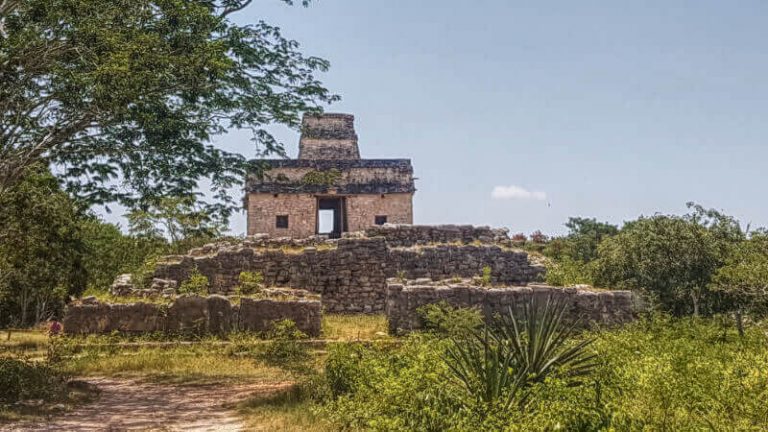
Tu guía más completa a Dzibilchaltún

Dzibilchaltún
Dzibilchaltún se encuentra a pocos minutos al norte de Mérida, y significa “Lugar donde se escribe sobre las piedras” en idioma Maya, en referencia a las numerosas lápidas memoriales encontradas en el sitio, también llamadas estelas.
Este sitio se distingue por su larga historia. Según los expertos, hubo asentamientos desde el 500 ANE, es posible que antes, y durante la conquista española alrededor del año 1540. Esta larga duración de estar habitado puede explicarse, entre otras cosas, por su ubicación privilegiada, a 17 km de la costa y el cercano a una zona de tierra fértil.
El asentamiento cubrió un área circular de unos 19 km2, en la que se han encontrado unas 8,400 estructuras. La parte central está formada por numerosas construcciones monumentales que cubren alrededor de 25 hectáreas. En el resto del área, hay restos arquitectónicos dispersos con pirámides y edificios abovedados. Se cree que podría haber alcanzado una población de hasta 40,000 habitantes, lo que la convierte en una de las ciudades antiguas más grandes de Mesoamérica.
Debido a su proximidad a la costa, su economía aprovechó los productos marinos de la costa del Golfo, produciendo sal, haciendo herramientas de caracol y consumiendo mariscos; también se aprovechaba la siembra y la cosecha de maíz.
Datos interesantes
- Al igual que en Chichén Itzá, se puede disfrutar de un fenómeno presentado por el sol en el equinoccio. En Dzibilchaltún se puede ver desde su largo Sacbé cómo aparece el sol en el centro de la puerta.
- El fenómeno de la luz y la sombra presentado en el equinoccio en Dzibilchaltún no se notó durante 26 años después de comenzar los primeros estudios de este sitio en 1956.
- El Cenote Xlakah encontrado en Dzibilchaltún es el más grande encontrado hasta la fecha en Yucatán, mide 100 m de norte a sur y 200 m de este a oeste con 44 m de profundidad donde los investigadores encontraron una abertura a otra cueva donde se desconoce su tamaño.
- Dzibilchaltún es una de las ciudades mayas más antiguas de la península.
Horario de acceso a Dzibilchaltún
Dzibilchaltún está abierto todos los días de 8:00 a 16:00.
Costo de entrada a Dzibilchaltún 2022
Cuando visites este Sitio Arqueológico Maya, deberás pagar 2 cuotas, uno para la Agencia de Administración Fiscal de Yucatán y otro para el Instituto Nacional de Artes e Historia.
Admisión General Dzibilchaltún
Cuota estatal: $ 197 MXN
Costo federal: $ 85 MXN
Total: $ 227 MXN
Ciudadanos mexicanos
Cuota estatal: $ 80 MXN
Costo federal: $ 85 MXN
Total: $ 165 MXN
Ciudadanos del Estado de Yucatán
Cuota estatal: $ 0 MXN
Tarifa federal: $ 85 MXN
Total: $ 85 MXN
Entrada gratuita para ciudadanos mexicanos los domingos.
Admisión gratuita todos los días para ciudadanos mexicanos con las siguientes identificaciones válidas: mayores de 60 años, jubilados, jubilados, profesores, estudiantes, niños menores de 13 años y discapacitados.
Acceso gratuito a Dzibilchaltún
Entrada gratuita para ciudadanos mexicanos los domingos.
Admisión gratuita todos los días para ciudadanos mexicanos con las siguientes identificaciones válidas: mayores de 60 años, jubilados, jubilados, profesores, estudiantes, niños menores de 13 años y discapacitados.
La mejor temporada para visitar Dzibilchaltún
Dzibilchaltún no es tan popular entre los turistas como Chichén Itzá o Tulúm, pero esta información también puede ayudar:
El mes perfecto para visitar este sitio arqueológico debido al buen clima y menos turistas es mayo.
El mejor momento de visitar el sitio durante el día es entre las 8 y las 11 am, y si no te gusta madrugar, puedes llegar entre las 2 y las 3 pm.
Tiempo estimado de recorrido
Relax: Cuando ingresas a Dzibilchaltún puedes caminar entre el museo y seguir el camino que te lleva al Sacbe 1. Desde aquí puedes ver el Templo de las 7 muñecas, pero no camines hacia él porque es una caminata muy larga. Es mejor si vas en dirección opuesta para ver todos los otros edificios y el Cenote.
Esto debería llevar menos de una hora.
Turista: Si quieres ver todo y detener solo para tomar fotografías, y un rápido baño en el Cenote Xlakah, puede tomar entre 1 y 2 horas.
Arqueólogo: Si ya leíste sobre la historia de Dzibilchaltún y sus edificios, es posible que prefieras explorar la arquitectura y los grabados alrededor de los monumentos, visitar el Museo e incluso nadar en el Cenote.
Esto puede tomar entre 2 a 3 horas.
Recomendaciones
- Prepárate para un rápido chapuzón en el Cenote Xlakah, así que trae tu traje de baño y refréscate del clima cálido de la Península Maya.
- Use zapatos cómodos. Puedes usar sandalias, pero es mejor llevar zapatos cerrados o tenis. Los caminos son un poco irregulares sin pavimentar, también tendrás que estar atento a las rocas y palos errantes.
- Protégete de los dañinos rayos UV. Puedes encontrar algunas sombras debajo de los árboles, pero la mayoría de las veces, estarás bajo la luz directa del sol, así que asegúrate de usar protector solar, un sombrero, y también puede ser una buena idea llevar una sombrilla.
- Llega temprano (o tarde). Trata de llegar entre las 8 y las 9 am porque no hay tanta gente y puedes tomar mejores fotos, además de que no hace tanto calor a esa hora.
Video de Dzibilchaltun
(10:13 minutes)

Conoce más sobre Dzibilchaltún y El templo de las Siete Muñecas Su Cenote Su Museo y más...
Desde Mérida son 28 km y se llega en aproximadamente 25 minutos.
Desde Cancún son 226 km y se llega en aproximadamente 3 horas y 20 minutos.
From Valladolid it’s 182 km and you get there in approximately 2 hours.
No te puedes perder...
Cuando visites Dzibilchaltún no olvides conocer:
El Templo de las 7 muñecas
Templo de las 7 Muñecas
Cenote Xlakah
Cenote Xlakah
Museo del Pueblo Maya
Museo de Dzibilchaltún
More about Dzibilchaltun
Short History of Tulum
Originally called Zamá, dawn or sunrise in Mayan language, was an important crossroad of commerce trade in both land and sea.
The buildings currently visible in Tulum, belong almost entirely to the last period of pre-Hispanic occupation of the Mayan Peninsula: the late postclassic period in the years 1200 to 1550. However, the presence and analysis with carbon 14 of some structures clearly belong to older periods, such as stela 1, and structure 59, which contains some stylistic elements of the classical period, indicate that the settlement may have originated at a considerable time oldest, perhaps the early classic, from 400 to 600 BC.
Not much is known about the first settlers in this area, however, thanks to archaeological evidence based on ceramics, the earliest occupation can be dated to 300 BC. “
Tulum and it’s beach
The greatest attraction of Tulum is the combination of the imposing ruins with the amazing tonalities of the Caribbean Sea.
This amazing Mayan city is small but impressive, located above a small cliff 15m above sea level limited by the blue-turquoise waters of the Caribbean Sea. The ruins of Tulum have one of the most beautiful beaches of the Riviera Maya.
Keep in mind you can access the beach when you visit Tulum, so make sure you bring your swimsuit.
Tulum’s East Coast style Architecture
Tulúm is the best and most well-known example of the East Coast style, a name that designates the architectural type of Mayan buildings built on the north coast of Quintana Roo between the years 1200 and 1520.
Being on the highest elevation of the region and for its efficient defensive system, this site was an unavoidable settlement for any commercial route and for the exploitation of the rich marine resources of the coast of Quintana Roo.
Tulum Archeological Site
In the Archaeological Site of the Tulúm we can find a ceremonial enclosure surrounded by a perimeter wall of five meters thick and five narrow doors that close the three flanks of terrestrial access. Inside, behind the Casa del Chultún is the House of Columns or Grand Palace, located opposite the House of Halach Uinic or Great Lord, which retains a large number of carvings and paintings.
On one side is the Temple of the Frescoes that was used as an observatory to follow the movement of the Sun. A large platform gives access to the best-known structure of the city: El Castillo, which in addition to its ceremonial functions worked as a beacon guiding the ships to avoid crashing against the coral reef near the coast. This building has a wide external staircase that leads to the Temple of the Initial Series, that seems to be related to the setting sun.
On the other side of the Caribbean beach on top of a large cliff is the Temple of the Wind, and very close to it there is a Sacbé or path that leads to the Cenote that provided drinking water to the city and that led to the House of the Cenote .
In addition to all these buildings there is a wooden staircase built next to the cliff that allows interested travelers to access the beach to swim in the beautiful beach near the city, this being another important attraction to visit.

